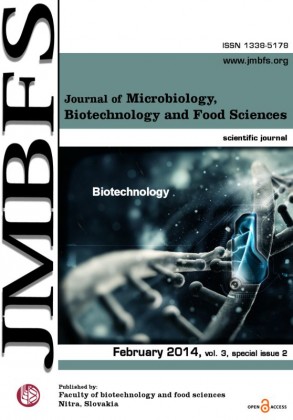EFFECTIVE COMPOUNDS OF POMEGRANATE AND THEIR EFFECT ON ANIMAL CELLS
Keywords:
Antioxidant, apoptosis, ellagic acid, pomegranate, punicalaginAbstract
This review describes possible effects of antioxidant compounds of pomegranate on animal cells. Pomegranate (Punica granatum L.) fruits are widely consumed. Pomegranate is one of the oldest known edible fruit. Spain is main producer in the Europe. Pomegranate contains bioactive polyphenols - punicalagin with molecular weight 1084. Part of punicalagin's molecule is ellagic acid. The both substances generate total antioxidant capacity of pomegranate. Punicalagin compounds present high antioxidant capacity - approximately 50%, ellagic acid as single molecule has 3% of antioxidant capacity. Punicalagin is molecule with high molecular weight and have to be hydrolised. Colonic microorganism metabolise yield of pomegranate (punigalagin or ellagic acid) to urolithin A and is detected in blood, urine or faeces. Extract from pomegranate can show anticarcinogenic effect, induction of cell - cycle arrest, apoptosis and proliferation. Extract from pomegranate has relieving effect on woman's menopausal symptoms, anxienty disorders, depression or attention deficit disorders. Ellagic acid introduces health benefits against cancer, cardiovascular diseases and other disease. It is possible, that compounds of pomegranates or their metabolites could have impact on different animal cells and regulate their intracellular mechanism.Downloads
Download data is not yet available.
Downloads
Published
2014-02-01
How to Cite
Packová, D., Maruniaková, N., Halenár, M., A. Carbonell-Barrachina, ÃÂngel, & Kolesárová, A. (2014). EFFECTIVE COMPOUNDS OF POMEGRANATE AND THEIR EFFECT ON ANIMAL CELLS. Journal of Microbiology, Biotechnology and Food Sciences, 3(special issue 2 (Biotechnology), 142–144. Retrieved from https://office2.jmbfs.org/index.php/JMBFS/article/view/7639
Issue
Section
Biotechnology
License
Copyright (c) 2014 Dagmara Packová, Nora Maruniaková, Marek Halenár, ÃÂngel A. Carbonell-Barrachina, Adriana Kolesárová

This work is licensed under a Creative Commons Attribution 4.0 International License.
All papers published in the Journal of Microbiology, Biotechnology and Food Sciences are published under a CC-BY licence (CC-BY 4.0). Published materials can be shared (copy and redistribute the material in any medium or format) and adapted (remix, transform, and build upon the material for any purpose, even commercially) with specifying the author(s).

